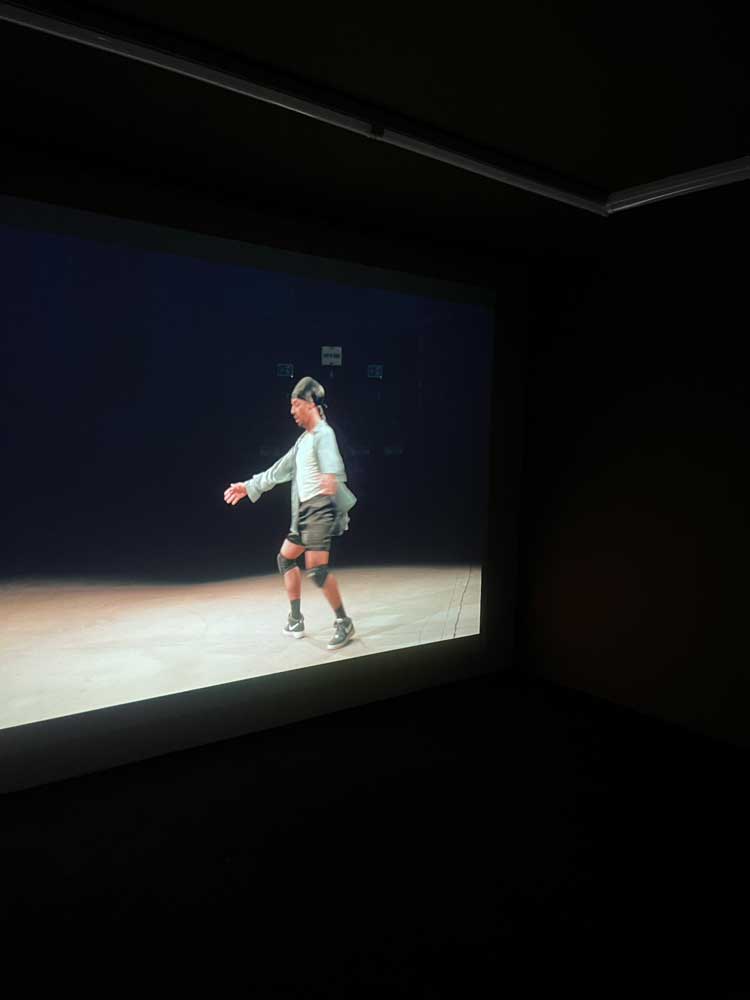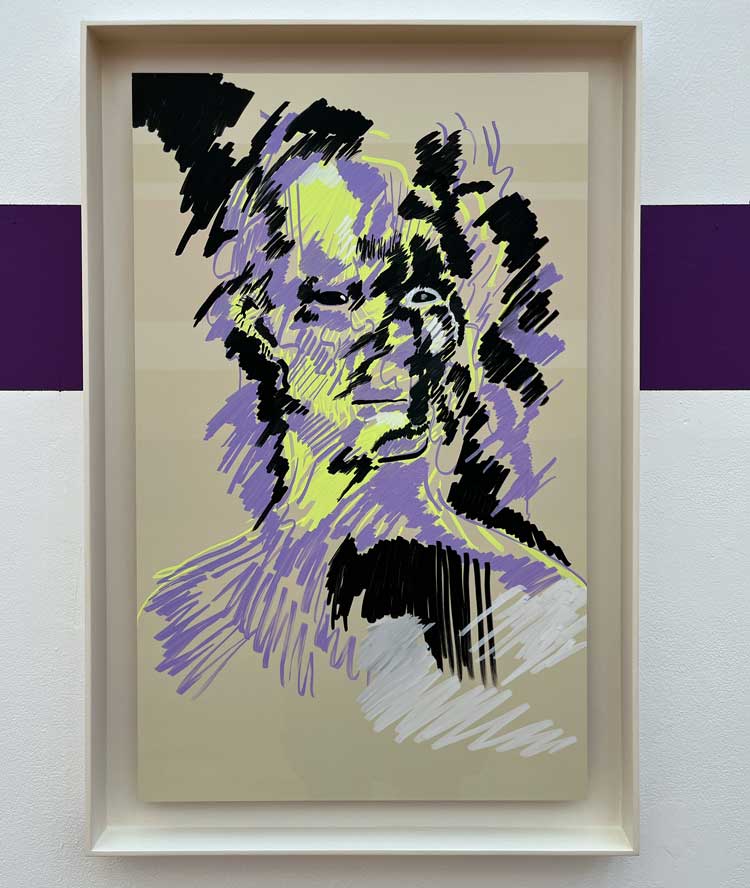-Rob-Battersby-9.jpg)
Paul Maheke: To be Blindly Hopeful, installation view, Mostyn Gallery, Llandudno, 2024. Photo: © Rob Battersby.
Mostyn Gallery, Llandudno
23 March – 29 June 2024
by VERONICA SIMPSON
Curtained off in an upstairs room at Mostyn, there is a powerful film of a performance by Paul Maheke (b1985, Brive-la-Gaillarde, France) that is integral to this, the artist’s largest solo UK institutional show to date. Admittedly, it is unlikely to be where you start your visit, given that the main galleries are on the ground floor, directly ahead of the entrance. But it would be a good place to begin. In fact, I recommend visitors grab a coffee, cake or lunch in the excellent first floor cafe. Replenish the senses, take sustenance, gird your loins. Maheke is inviting us into some deep and occasionally harrowing emotional territory.

Paul Maheke. Scene from the filmed performance of Taboo Durag, 2021. Installation view, To be Blindly Hopeful, Mostyn Gallery, Llandudno, 2024. Photo: Veronica Simpson.
The film, Taboo Durag (2021), was developed from a performance piece Maheke devised for Glasgow International in 2021. It evolved from a period of intense introspection and journalling, facilitated by the Covid lockdowns of 2020-21, during which time Maheke allowed himself to acknowledge the coercive abuse and violence he had been subjected to in a recently ended relationship. Fragments of his journals, as he processes dreams, flashbacks, insights and reflections, float across the screen, against a quietly affecting soundscape created by Simon Maheke. But the dominant element in the film is the solitary figure of the artist in a dark and empty room. Over the film’s 30-minute duration, we see his body sequencing through a slow standing shake, then a shuddering and shivering, to more vigorous releasing of what is clearly embodied trauma, anger, shame and confusion. We see him stamping, circling with his arms held wide in a kind of gentle waltz, and finally spinning quietly while sitting down.
-©Rob-Battersby-11.jpg)
Paul Maheke: To be Blindly Hopeful, installation view, Mostyn Gallery, Llandudno, 2024. Photo: © Rob Battersby.
He describes the performance as a “dance meditation”. Though he is not re-enacting traumatic events so much as processing them. Certainly, there is a sense of healing, of emerging, as the title of his show suggests, into a space that could be “hopeful”. The title of his show is taken from the last line of his journal – a printout of which is made available – yet after watching the film, other lines strikes me as particularly on point: “I danced while elevating my unresolved dead.” And: “Whatever is in the dark will come to light.”
Downstairs, some marvellous things have indeed come to light. During that first year of Covid, confined to his flat, and without art materials, Maheke began to draw, initially using a graphic pad, then switching to an iPad as he discovered that this technology could be wonderfully expressive. Later evolutions of his digital drawings form the main body of the show, most of them from 2023 and 2024. They are an uncanny assembly of characters, bearing animal, mythical and human characteristics, often layered, sometimes clearly one or the other, arranged around two rooms. He describes them as “beings”, some painted on aluminium. Before the show’s opening, he tells us: “I came back to drawing, which is where I started: I wanted to become a medical illustrator. That’s how I entered art school.” These drawings began, he says, “as a form of improvisation, and letting the images emerge rather than thinking about what I want to portray or create, so they are a reflection of those moments and feelings. There’s a little bit of a spiritual undertone as always in my work with these accompanying presences.”
-Rob-Battersby-18.jpg)
Paul Maheke: To be Blindly Hopeful, installation view, Mostyn Gallery, Llandudno, 2024. Photo: © Rob Battersby.
These beings are arranged to suit the dramatic, top-lit space of the main gallery, positioned in relation to a series of painted horizontal stripes, in varied thicknesses, and shades of purple, green, pink and palest blue. Maheke calls these a “kind of abstracted landscape … the measurements are based on some of my proportions, sometimes my height, sometimes double my height. It’s a way to bring my presence into this space, that is not necessarily immediate and visual. We can even call it a self-portrait.”
-Pic-V-Simpson.jpg)
Paul Maheke. The Purple Chamber, 2023. Installation view, To be Blindly Hopeful, Mostyn Gallery, Llandudno, 2024. Photo: Veronica Simpson.
In a smaller, side room is an installation The Purple Chamber (2023). On either side, the walls are lined in violet-coloured, soft drapes, while from the far wall a large barn owl, its face intent, alert, glides towards us. It has seemingly cast an object to one side, a sort of spherical thing, with long hairs or spines protruding from its skin. On closer inspection, this pellet appears to have eyes, a gaping mouth; has it been birthed, excreted or consumed? Maheke tells us: “The owl is a bird of high significance in many cultures. This is a bird that embodies wisdom. The owl that keeps coming back in my work is the barn owl, which is the one that carries secrets with it.” Perhaps this spiky thing is its secret.

Installation view, Paul Maheke: To be Blindly Hopeful, Mostyn Gallery, Llandudno, 2024. Photo: Veronica Simpson.
Maheke does throw us a few clues in the titles of these drawings. There are three characters placed directly on the walls, all of which are from a series called To Be Blindly Hopeful (2024). One is panther-like, sleek and hungry, powerful, while the owl-like character placed high on the far wall of the main gallery suggests serenity: the eyes are calm, there is a radiance in this softly furred/feathered creature. A tall, somewhat spectral figure, acrylic pencil on aluminium, hovers on the adjacent wall, titled simply The Purple Chamber Series (V); it is more obviously human, but with a glowing pelt or robe of flesh-like shreds. Maheke, as he reminds us, studied anatomical drawing first. And there is a sense of linear progression here, perhaps, from his youthful ambition to articulate the actual flesh and bone of our human anatomy. Here, it is the energetic, emotional body being articulated and somehow released, liberated to share something deeply intimate and also universal about our experiences, our senses.
-Rob-Battersby-10.jpg)
Paul Maheke, Ancestral Muse II (blue), 2023. Acrylic pencil on aluminium panels, 50 x 75 cm. Photo: © Rob Battersby.
Ancestral Muse II (blue) (2023), acrylic on aluminium, also seems a mix of foxy and feline, with a shimmering luminosity conjured by palette and materials. Ancestral Muse I (night blue and sodium brown) (2023) feels more like a human-animal blend, a masked creature of the kind that still populates ancient seasonal rituals around the world. I ask Maheke which mythologies he was drawing from to create these works. He says they were mostly inspired by stories his Congolese-born father told him and his siblings, when they were kids: “We didn’t have TV until I was about 12, so we had the radio and also there was this tradition where every night we had him telling us stories. And the stories always had beings that literally are impossible to … imagine how they would exist physically, such as a man that only has half of his body but can still move through the forest. I was producing a show in London, called Ancestral Musing [at Goodman Gallery, which represents him, in 2023] and it had to do with connecting back to those creations that have populated my imagination as a kid. It’s funny because I know it can look monstrous, but for me they’re benevolent.”
The imagery across the exhibition marks a journey through Maheke’s conscious or subconscious imagination during the period between acknowledging the trauma and his recovery – for he seems recovered now, grounded, clear about the purpose of this work, of the importance of revealing and voicing this experience.

Paul Maheke, Ancestral Muse IV, 2023. Acrylic pencil on aluminium panel, 75 x 50 cm. Photo: Veronica Simpson.
Of the performance upstairs, Maheke says: “It is the only work that I’ve produced while being afraid of how it would be received because I knew that the main mission of that work was for me to give weight to my voice. in a way, I didn’t even care if the work was bad or not, I knew it was necessary. And when I presented it to different audiences it was very interesting to see that always there were people coming up to me and talking about their experiences. It opened up a space for conversation that I didn’t know could exist in that way. And that was very powerful.”
Through these explorations, Maheke has arrived at an interesting place and embarked on a fascinating body of work. That final line in his journal, in full, is: “I wish I could remember, in my bones and flesh, what it feels like to be blindly hopeful.” I think he has found a way.